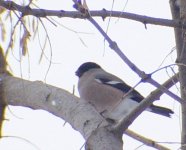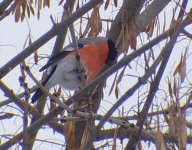I got following information from Rico Kuehn:
I am almost sure, that in West Europe now really (together with local and Eastern-European) the Bullfinches of the Caucasian subspecies Pyrrhula pyrrhula rossikowi can be observed.
Judging on received photos, males are very bright, red colour is spread practically up to vent. Our Bullfinches are paler. By voice there are also distinctions from Eastern-European Bullfinches. Represented calls are more jerky, they are of another tonality, less soft and less minor, than in our "guys". That was confirmed independently by several specialists during hearing these recording. I don't know Caucasian subspecies of the Bullfinches "in face" very well, I saw them a couple of times in the Caucasian Nature Reserve, therefore this assumption should be confirmed by other more experienced specialists. It is written that this subspecies undertakes only vertical nomadic movements. I can guess only that powerful snowfalls in Turkey had a certain influence on this invasion, where this subspecies inhabits the southern coast of the Black Sea. I have heard from TV, that in the Northern Caucasia snow cover has appeared by 1 month earllier that it should be. What does it mean - our stereotype of
thinking.: if Bullfinches, means they should be from N or E, but in fact they are - from South-East !
Oleg Boroodin, Ulyanovsk, Russia





